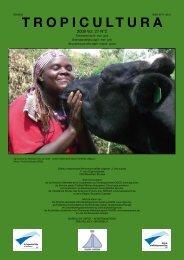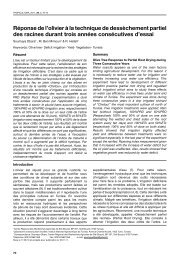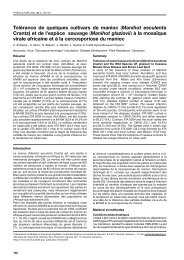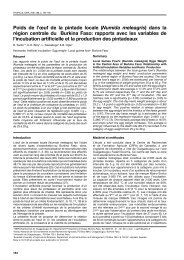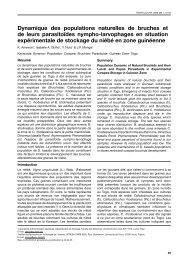Fascicule entier - Tropicultura
Fascicule entier - Tropicultura
Fascicule entier - Tropicultura
You also want an ePaper? Increase the reach of your titles
YUMPU automatically turns print PDFs into web optimized ePapers that Google loves.
laboratory conditions. It consists of mixing powders<br />
of repellent and insecticide plants. Plants are chosen<br />
among those used regularly by farmers. Plants<br />
considered as effective by farmers are collected from<br />
the nature, dried and powdered separately. Powders<br />
from different plant species are mixed at equal<br />
proportion (10) during the formulation of the doses.<br />
Under laboratory conditions, 20-40 g plant powders/<br />
kg of bean seeds was found to be effective doses<br />
(8, 10). In this experiment, 3 doses were evaluated<br />
alongside farmers’ ones: 0, 0.1, 0.2 kg powders / 5 kg<br />
of bean seeds.<br />
The trial was conceived and set up in collaboration<br />
with members of the two farmers’ groups. With ADEA,<br />
two bean varieties were used: Majambere (VCB) and<br />
Katabonimbwa (Kirundo). In partnership with JAK, five<br />
popular and marketable bean varieties were used:<br />
M’Lwera (Mafutala), Kirundo, Haricot Soja (G2333),<br />
Ishikazi (local variety) and Namakala.<br />
Five to ten kg of bean seeds was admixed with fresh<br />
leaves or with plant powders. The products (beans<br />
+ plant materials) were stored in sacks (common<br />
storage envelops) and kept in storerooms of the<br />
farmers’ associations. These sacks were kept in a<br />
dry, cool and lighted place. Sacks used were bought<br />
by farmers. Before storing, bean seeds bought from<br />
farmers, were put in a fridge (refrigerator at 4 °C) for 4<br />
days to minimize late infestation dues to young stages<br />
of bruchids from the fields.<br />
Members of the two associations were required to<br />
take care of trials and protecting them against any<br />
disturbance from children, rats…<br />
Bruchids (Acathoscelides obtectus L.) were artificially<br />
released in all the treatments at the rate of 20 (for<br />
JAK) and 50 (ADEA) unsexed adult bruchids. At each<br />
association, the rate of bruchids infestation depended<br />
on their availability in the area. The storage period<br />
was of 6 months, and immediately after that time, the<br />
experiments were evaluated.<br />
At the evaluation, extension staff, village chiefs as well<br />
as the association members (men and women) were<br />
invited. Farmers were requested to give own opinion<br />
or perception on the performance of each method or<br />
dose in conserving/protecting bean seeds against<br />
bruchid attacks during 6 months of storage.<br />
During the evaluation, three parameters were<br />
appreciated: the number of emerged bruchids, the<br />
percentage of seeds damaged and the percentage of<br />
weight loss.<br />
Weight loss was evaluated using Shulten (1, 4, 19)<br />
equation, as follows:<br />
% Weight loss (Y):<br />
(Wu.Nd)-(Wd.Nu)<br />
Y= ------------------<br />
Wu (Nd+Nu)<br />
Where:<br />
TROPICULTURA<br />
Wu= weight of undamaged seeds;<br />
Wd= weight of damaged seeds (perforated grains);<br />
Nu= number of undamaged seeds;<br />
Nd= number of damaged seeds.<br />
Data analysis<br />
All data were subjected to analysis of variance<br />
(ANOVA), after checking the validity of the assumptions<br />
underlying this test. For skewed data distribution, raw<br />
data were transformed and adjusted to approximate<br />
the normal distribution. Percentage of seeds damaged<br />
and percentage of weight loss data were subjected<br />
to arcsin√x transformation. The number of emerged<br />
bean bruchids data was also subjected to natural<br />
logarithmic [Xt= ln(x + 1)]. Where the F-statistics<br />
indicated significant effects, means were separated<br />
using Fisher’s protected least significant difference<br />
(LSD) test at 5% probability level. All analyses were<br />
conducted with the Genstat computer package<br />
programme (Genstat 5 release 3.2 PC/Windows 95).<br />
Results<br />
For both ADEA and JAK associations, ANOVA revealed<br />
significant (P< 0.05) effects for bruchids management<br />
practices (methods), doses and bean varieties used.<br />
However, regarding the percentage of weight loss,<br />
with JAK farmers’ association, ANOVA did not reveal<br />
significant (P> 0.005) effects of treatments (doses,<br />
methods).<br />
The proliferation of bruchids in farmers’ stores was<br />
significantly influenced by the management practices<br />
applied. The “scientific method’ was effective in<br />
controlling bean bruchids at the rate of 0.2 kg<br />
powders/5 kg of bean seeds. In fact, with the improved<br />
method, the population of emerged bruchids, was of<br />
122-106 (dose 3), (Table 1) and 10-32 (dose 3), (Table<br />
4) against 746-2920 (control), (Table 1) and 126-438<br />
(control), (Table 4), for ADEA and JAK associations<br />
respectively.<br />
With the “scientific method”, the dose of 0.2 kg<br />
powders/5 kg of bean seeds significantly (P< 0.05)<br />
reduced bruchids attacks and weight losses in<br />
farmers’ stores. At that dose, the percentage of weight<br />
loss was of 0.19-3.54 % (Table 2), 1.3-8.6% (Table 5)<br />
against 23.4-71.08% (control), (Table 2) and 27.6-58%<br />
(control), (Table 5). The percentage of seeds damaged<br />
(perforated) by bruchids was of 1-1.8 (Table 3) and<br />
177



